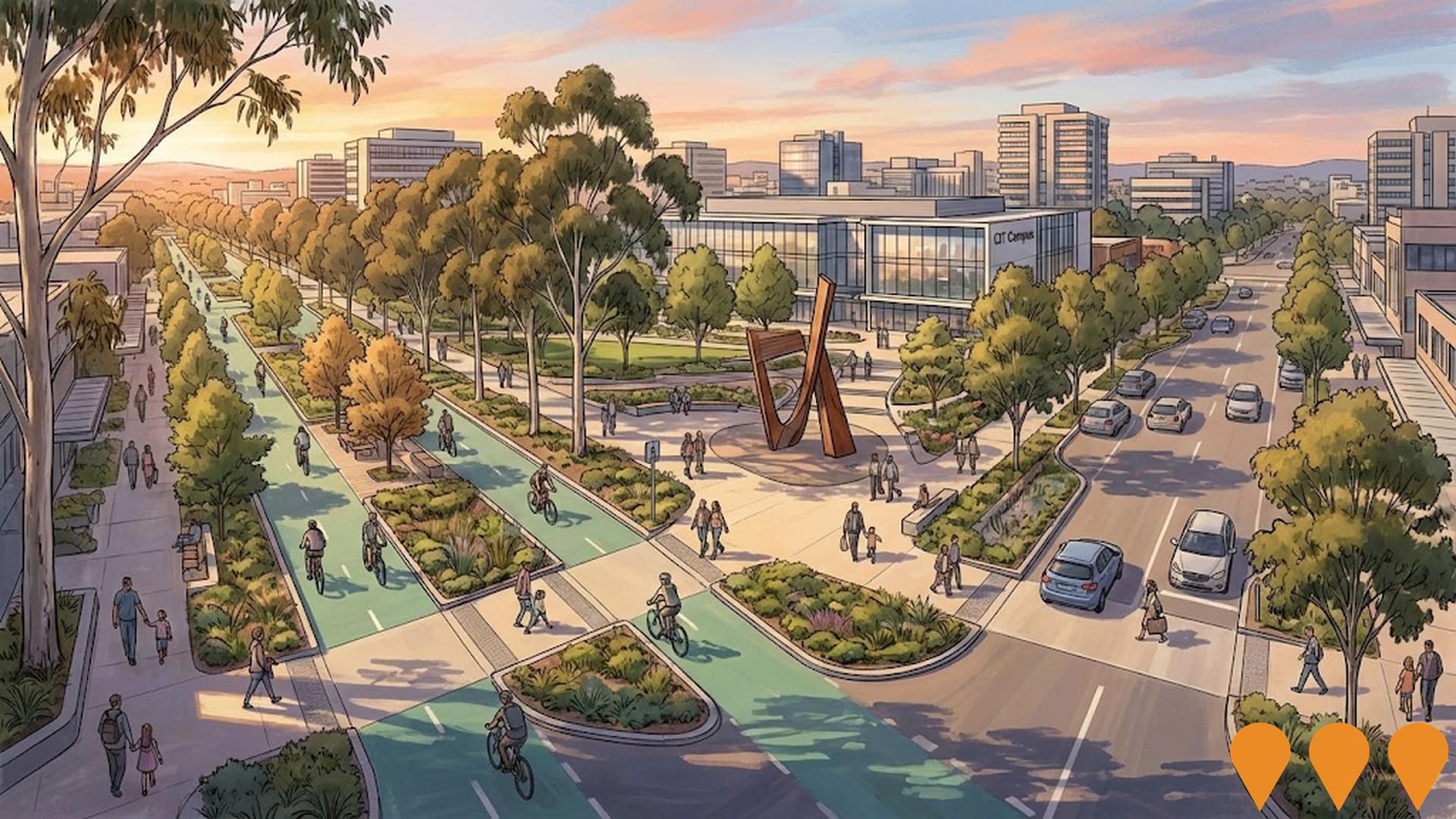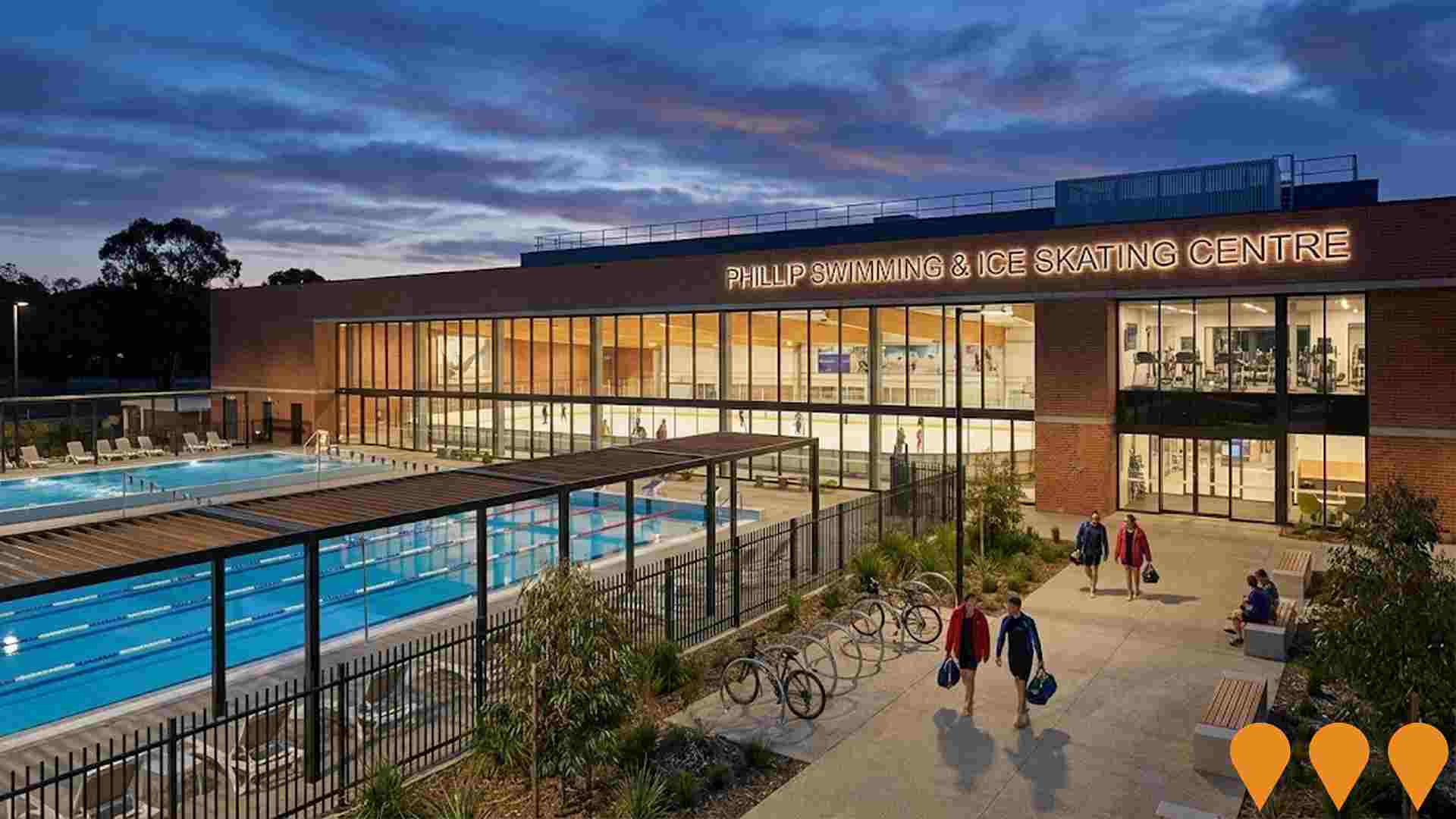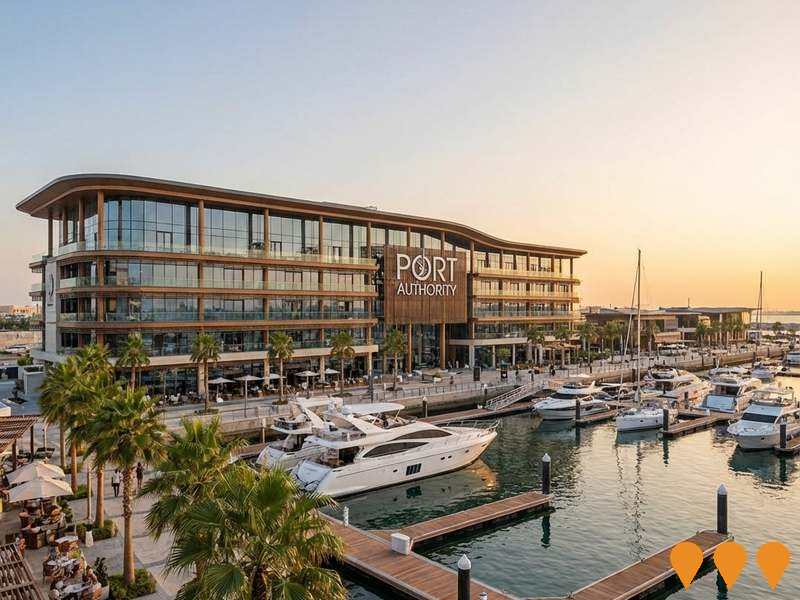Chart Color Schemes
est. as @ -- *
ABS ERP | -- people | --
2021 Census | -- people
Sales Activity
Curious about local property values? Filter the chart to assess the volume and appreciation (including resales) trends and regional comparisons, or scroll to the map below view this information at an individual property level.
Find a Recent Sale
Sales Detail
Population
Mawson has seen population growth performance typically on par with national averages when looking at short and medium term trends
Mawson's population was approximately 3,490 as of August 2025. This figure represents an increase of 50 individuals, a rise of 1.5%, since the 2021 Census which reported a population of 3,440 people. The change is inferred from the estimated resident population of 3,476 in June 2024 and an additional 48 validated new addresses since the Census date. This equates to a density ratio of 1,654 persons per square kilometer, exceeding the average across national locations assessed by AreaSearch. Overseas migration contributed approximately 75.7% of overall population gains during recent periods, driving primary growth in the area.
AreaSearch adopts ABS/Geoscience Australia projections for each SA2 area, released in 2024 with a base year of 2022. For areas not covered and years post-2032, age group growth rates from the ACT Government's SA2 area projections are used, also with a base year of 2022. Considering projected demographic shifts, lower quartile growth is anticipated nationally, with Mawson expected to increase by 48 persons to 2041 based on latest population numbers, recording an overall gain of 0.9% over the 17-year period.
Frequently Asked Questions - Population
Development
Residential development activity is lower than average in Mawson according to AreaSearch's national comparison of local real estate markets
Mawson has recorded approximately 15 residential properties granted approval annually. Over the past five financial years, from FY21 to FY25, 76 homes were approved, with an additional 17 approved in FY26 so far. On average, one new resident arrives per year for each new home over these five financial years, indicating a balanced supply and demand market that supports stable conditions.
The average expected construction cost value of new dwellings is $357,000. In FY26, approximately $1.1 million in commercial approvals have been registered, suggesting minimal commercial development activity compared to the Australian Capital Territory, where Mawson has 73.0% less development activity per person. This limited new supply generally supports stronger demand and values for established dwellings. The new development consists of 46.0% standalone homes and 54.0% townhouses or apartments, focusing on higher-density living that creates more affordable entry points and suits downsizers, investors, and first-home buyers. With around 379 people per dwelling approval, Mawson shows a developed market with future projections indicating an addition of 32 residents by 2041.
Based on current development patterns, new housing supply should readily meet demand, offering good conditions for buyers and potentially facilitating population growth beyond current projections.
Frequently Asked Questions - Development
Infrastructure
Mawson has strong levels of nearby infrastructure activity, ranking in the top 40% nationally
Changes to local infrastructure significantly influence an area's performance. AreaSearch has identified two projects that may impact this region. Major initiatives include Mixed-Use Complex In Mawson, Phillip Swimming And Ice-Skating Centre Redevelopment, Woden Town Square Precinct Redevelopment, and Canberra Hospital Master Plan. The following details those most relevant:.
Professional plan users can use the search below to filter and access additional projects.
INFRASTRUCTURE SEARCH
 Denotes AI-based impression for illustrative purposes only, not to be taken as definitive under any circumstances. Please follow links and conduct other investigations from the project's source for actual imagery. Developers and project owners wishing us to use original imagery please Contact Us and we will do so.
Denotes AI-based impression for illustrative purposes only, not to be taken as definitive under any circumstances. Please follow links and conduct other investigations from the project's source for actual imagery. Developers and project owners wishing us to use original imagery please Contact Us and we will do so.
Frequently Asked Questions - Infrastructure
Canberra Hospital Master Plan
Long-term transformation of Canberra Hospital campus (2021-2041). The new Critical Services Building (Building 5) opened in 2023. Multiple stages are now in construction or detailed planning, including SPIRE Stage 1 (new emergency, surgical and intensive care facilities) and ongoing campus renewal works to deliver modern clinical facilities.

Woden Town Square Precinct Redevelopment
A major mixed-use urban renewal precinct featuring a new public town square, residential apartments, commercial office space, retail, and community facilities as the centrepiece of Woden's revitalisation.

Canberra Hospital Critical Services Building (SPIRE Centre)
Australia's first fully-electric hospital building, the Canberra Hospital Critical Services Building (also known as SPIRE Centre), is an eight-storey, 45,000 square metre facility. It includes a new Emergency Department with 128 treatment spaces, a 48-bed Intensive Care Unit with two outdoor terraces, 22 operating theatres, 148 inpatient beds, cardiac catheter laboratories, and enhanced radiology and pathology services. The largest healthcare infrastructure project in ACT history, it was built by Multiplex with a 5 Star Green Star design rating, featuring innovative sustainability measures. Completed and opened August 2024.

Woden Experiment Stage 2 - Public Realm & Active Travel Upgrades
Major public realm upgrades including new cycling paths, widened footpaths, tree planting, public art and improved connectivity around the new CIT Campus and town centre.

Phillip Swimming And Ice-Skating Centre Redevelopment
Comprehensive redevelopment of aquatic and ice sports facility with modern amenities, expanded capacity, and improved accessibility.

Mixed-Use Complex In Mawson
Development of 92 apartments with commercial components, designed by Oztal Architects, includes two buildings and basement parking.

Woden Green
A three-tower residential development by Hindmarsh offering one, two, and three-bedroom apartments. The project emphasizes spacious living, modern amenities, and significant communal green spaces as part of Woden urban renewal initiatives. Close to the Woden Town Centre, Woden Green offers vertical community living and is part of the broader urban renewal and densification of the Woden area.

Affordable Housing Project Fund
A $60 million initiative to construct 70 affordable rental homes within a 140-unit build-to-rent development, aimed at strengthening the community housing sector and enhancing the availability of affordable rentals.

Employment
The labour market in Mawson demonstrates typical performance when compared to similar areas across Australia
Mawson's workforce is highly educated with significant representation in essential services sectors. The unemployment rate was 3.3% as of June 2025.
Employment grew by 1.7% over the past year. In June 2025, 1,921 residents were employed with an unemployment rate 0.1% lower than the Australian Capital Territory's rate of 3.4%. Workforce participation was at 66.3%, below the ACT's 69.6%. Key industries for employment among residents are public administration & safety, health care & social assistance, and professional & technical services.
Health care & social assistance has a notable concentration with employment levels at 1.6 times the regional average. Public administration & safety has limited presence at 27.8% compared to the regional average of 30.4%. The predominantly residential area offers limited local employment opportunities as indicated by Census data. Between June 2024 and June 2025, employment levels increased by 1.7%, labour force grew by 1.6%, and unemployment fell by 0.1 percentage points. In comparison, the Australian Capital Territory saw employment rise by 1.9% and unemployment fall by 0.3 percentage points over the same period. Jobs and Skills Australia's national employment forecasts from May 2025 project a 6.6% increase in employment over five years and 13.7% over ten years. Applying these projections to Mawson's employment mix suggests local growth of approximately 6.9% over five years and 14.2% over ten years, though these are simple extrapolations for illustrative purposes only.
Frequently Asked Questions - Employment
Income
Income metrics indicate excellent economic conditions, with the area achieving higher performance than 75% of national locations assessed by AreaSearch
Mawson's median taxpayer income was $65,691 and average income was $87,844 according to AreaSearch's postcode level ATO data for the financial year 2022. This is notably high compared to Australia's median income of $68,678 and average income of $83,634 in the Australian Capital Territory. By September 2025, estimates suggest Mawson's median income would be approximately $74,625 and average income around $99,791, based on a 13.6% increase from financial year 2022 as per Wage Price Index growth. Census 2021 data ranks Mawson's household, family, and personal incomes highly, between the 78th and 89th percentiles nationally. The earnings profile shows that 33.0% of residents (1,151 people) fall within the $1,500 - $2,999 income bracket, reflecting regional patterns where 34.3% occupy this range. Economic strength is evident with 34.9% of households earning high weekly incomes exceeding $3,000, supporting elevated consumer spending. Housing accounts for 13.6% of income, and residents rank within the 81st percentile for disposable income. The area's SEIFA income ranking places it in the 8th decile.
Frequently Asked Questions - Income
Housing
Mawson displays a diverse mix of dwelling types, with a higher proportion of rental properties than the broader region
The latest Census evaluated Mawson's dwelling structures as 54.2% houses and 45.8% other dwellings (semi-detached, apartments, 'other' dwellings), compared to the Australian Capital Territory's 58.4% houses and 41.7% other dwellings. Home ownership in Mawson was 32.9%, with mortgaged dwellings at 30.7% and rented dwellings at 36.4%. The median monthly mortgage repayment in Mawson was $2,167, aligning with the Australian Capital Territory average, while the median weekly rent was $400, compared to the Australian Capital Territory's $2,167 and $440 respectively. Nationally, Mawson's median monthly mortgage repayments exceeded the Australian average of $1,863, and rents surpassed the national figure of $375.
Frequently Asked Questions - Housing
Household Composition
Mawson has a typical household mix, with a fairly typical median household size
Family households comprise 66.9% of all households, including 27.4% couples with children, 28.9% couples without children, and 9.1% single parent families. Non-family households make up 33.1%, consisting of 29.2% lone person households and 3.6% group households. The median household size is 2.4 people, which aligns with the Australian Capital Territory average.
Frequently Asked Questions - Households
Local Schools & Education
Educational achievement in Mawson places it within the top 10% nationally, reflecting strong academic performance and high qualification levels across the community
Mawson's educational attainment significantly exceeds broader benchmarks. Among residents aged 15 and above, 53.0% hold university qualifications, compared to Australia's 30.4% and the SA4 region's 46.8%. This high level of educational attainment positions Mawson strongly for knowledge-based opportunities. Bachelor degrees are the most common at 31.1%, followed by postgraduate qualifications (16.1%) and graduate diplomas (5.8%).
Vocational pathways account for 23.6% of qualifications, with advanced diplomas at 11.4% and certificates at 12.2%. Educational participation is notably high in Mawson, with 30.6% of residents currently enrolled in formal education. This includes 9.5% in primary education, 7.2% in tertiary education, and 6.9% pursuing secondary education. Two schools serve the area: Mawson Primary School and Canberra Christian School, collectively educating 698 students. The area demonstrates above-average socio-educational conditions (ICSEA: 1089). Both schools focus exclusively on primary education, with secondary options available in surrounding areas.
Frequently Asked Questions - Education
Schools Detail
Nearby Services & Amenities
Transport
Transport servicing is moderate compared to other areas nationally based on assessment of service frequency, route connectivity and accessibility
Mawson has 17 active public transport stops, all of which are bus stops. These stops are served by three different routes that together facilitate 496 weekly passenger trips. The accessibility of these services is rated as good, with residents located an average of 219 meters from the nearest stop.
On average, there are 70 trips per day across all routes, which equates to approximately 29 weekly trips per individual stop.
Frequently Asked Questions - Transport
Transport Stops Detail
Health
Mawson's residents are healthier than average in comparison to broader Australia with prevalence of common health conditions quite low among the general population though higher than the nation's average across older, at risk cohorts
Health data shows relatively positive outcomes for Mawson residents. Prevalence of common health conditions is quite low among the general population but higher than the national average in older, at-risk cohorts. Private health cover rate is exceptionally high at approximately 64% of the total population (2,226 people), compared to 68.1% across Australian Capital Territory and a national average of 55.3%.
The most common medical conditions are arthritis and mental health issues, affecting 8.3 and 7.6% of residents respectively. 70.8% of residents declare themselves completely clear of medical ailments, compared to 70.1% across Australian Capital Territory. The area has 18.4% of residents aged 65 and over (641 people).
Frequently Asked Questions - Health
Cultural Diversity
Mawson is among the most culturally diverse areas in the country based on AreaSearch assessment of a range of language and cultural background related metrics
Mawson's cultural diversity is notable, with 35.5% of its population born overseas and 30.6% speaking a language other than English at home. Christianity is the predominant religion in Mawson, comprising 40.9% of the population. Hinduism stands out as overrepresented compared to the Australian Capital Territory average, making up 8.9% of Mawson's population versus 6.6%.
The top three ancestry groups are English (20.8%), Australian (19.5%), and Other (17.5%). Some ethnic groups show significant differences: Welsh is overrepresented at 0.9% compared to the regional average of 0.6%, Hungarian at 0.5% versus 0.3%, and Russian also at 0.5% against a regional average of 0.3%.
Frequently Asked Questions - Diversity
Age
Mawson's population is slightly younger than the national pattern
Mawson's median age is 38 years, which is higher than the Australian Capital Territory average of 35 but equivalent to the Australian median of 38. Compared to the Australian Capital Territory, Mawson has a higher percentage of residents aged 65-74 (9.5%) but fewer residents aged 15-24 (11.3%). Between the 2021 Census and now, the population aged 15-24 has increased from 9.9% to 11.3%, while the 45-54 age group has grown from 11.5% to 12.5%. Conversely, the 25-34 age group has decreased from 16.6% to 15.2%, and the 75-84 age group has dropped from 7.1% to 6.1%. By 2041, Mawson's age profile is projected to change significantly. The 65-74 age cohort is expected to grow by 26%, adding 86 residents to reach a total of 418. Residents aged 65 and above will drive 67% of population growth, indicating demographic aging trends. Meanwhile, the 5-14 and 0-4 age cohorts are projected to experience population declines.


